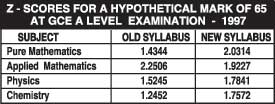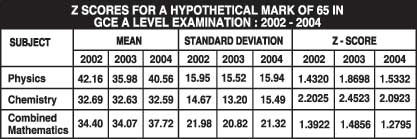Reply To:
Name - Reply Comment
 By Dr (Mrs ) Dhanapali Kottahachchi
By Dr (Mrs ) Dhanapali Kottahachchi
BSc Honours ( Cey), MSc Statistics
( London School of Economics),
PhD Statistics ( Colombo)
The university education in Sri Lanka was in the English medium at the inception. The students sat for the qualifying examination in the English medium. After the switch over to the mother tongue students are educated and sat for the GCE A Level examination in either the Sinhala or Tamil language. Thus the use of standardized marks according to the medium to compute the rank order merit list commenced in 1971 and continued until it was abandoned in 1978.
Standardization of marks is equivalent to the calculation of the present Z - scores for university admission.
Z - Score = (Individual subject mark - Mean ) / Standard Deviation
Two papers for the GCE A Level Examination - 1997
In 1997, the examinations department had two papers for a subject due to a revision of the syllabus. The students who sat for the first attempt sat for the new syllabus while the others who had repeated the examination sat for the old syllabus. The department pooled all the raw marks together and the total of the four subjects were considered for admission.

Reduction of the number of subjects to 3 from 4
The number of subjects was reduced to 3 from 4 in the year 2000. Although there were two sets of marks, the University Grants Commission (UGC) used the raw marks for admission in the first year even after the change. Only after one year, in 2001 Z - Scores were introduced.
Analysis of Published data
Mean and Standard deviation of GCE A/L students are included in the Statistical Hand Books published by the examinations department. Hence Z – Scores were computed for a hypothetical mark of 65 at the GCE AL examination.
Four/three subjects in the Physical Science stream were examined as an example to illustrate the impact.
Z - Scores for a hypothetical mark of 65 at GCE A Level Examination - 1997
Analysis revealed that the students who sat for Applied Mathematics at the first attempt had a lower score than those who had repeated the examination. In contrast, the students who sat for the remaining 3 subjects (Physics, Pure Mathematics and Chemistry) had a higher value than those who sat for the first time while a low value than those students who had repeated the examination.
The raw marks were used instead of Z - Scores. Hence these results did not affect any category of students.
.jpg)
Z Scores for a hypothetical mark of 65 in GCE A Level Examination : 2002 - 2004
Z - Score depends on the mean and the standard deviation of raw marks. Z - score computed for a hypothetical mark of 65 is the highest ( more than 2 ) for Chemistry during 2002 - 2004. The lowest is for Combined Mathematics. Furthermore, Chemistry is not favoured by the Physical science students. Individual Z - Scores are added to calculate the overall Z- Score which is used to prepare the merit list.
In 2004, the Z – Score for Chemistry was 2.0923. A student has to get 74 marks for Physics and 82 for Combined Mathematics to achieve this score.
The relevant authorities having access to raw data should have conducted an extensive analysis to find the implications for each subject after the introduction of a new method. It is not too late even after 10 years to assess the implications which will benefit the future generation for a just and fair university selection.
( The writer is a former Director/Planning and Statistician/Econometrician of University Grants Commission, Sri Lanka)